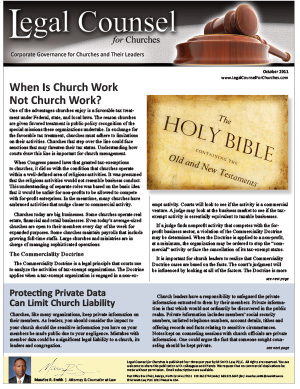One of the advantages churches enjoy is a favorable tax treat- ment under Federal, state, and local laws. The reason churches are given favored treatment is public policy recognition of the special missions these organizations undertake. In exchange for the favorable tax treatment, churches must adhere to limitations on their activities. Churches that step over the line could face sanctions that may threaten their tax status. Understanding how courts draw this line is important for church management.
When Congress passed laws that granted tax-exemptions to churches, it did so with the condition that churches operate within a well-defined area of religious activities. It was presumed that the religious activities would not resemble business conduct. This understanding of separate roles was based on the basic idea that it would be unfair for non-profits to be allowed to compete with for-profit enterprises. In the meantime, many churches have embraced activities that nudge closer to commercial activity.
Churches today are big businesses. Some churches operate real estate, financial and retail businesses. Even today’s average-sized churches are open to their members every day of the week for expanded purposes. Some churches maintain payrolls that include growing full-time staffs. Large churches and ministries are in charge of managing sophisticated operations.
The Commerciality Doctrine
The Commerciality Doctrine is a legal principle that courts use to analyze the activities of tax-exempt organizations. The Doctrine applies when a tax-exempt organization is engaged in a non-exempt activity. Courts will look to see if the activity is a commercial venture. A judge may look at the business market to see if the tax- exempt activity is essentially equivalent to taxable businesses.
If a judge finds nonprofit activity that competes with the for- profit business sector, a violation of the Commerciality Doctrine may be determined. When the Doctrine is applied to a non-profit, at a minimum, the organization may be ordered to stop the “com- mercial” activity or face the cancellation of its tax-exempt status.
It is important for church leaders to realize that Commerciality Doctrine cases are based on the facts. The court’s judgment will be influenced by looking at all of the factors. The Doctrine is more likely to be found by courts when the organization’s practices also violate other principals of law. For instance, excessive compensation levels paid to executives can inflate the set of facts. Without the excessive compensation levels paid, a court might otherwise determine that the commercial activity was merely incidental.
A church should be aware of how it appears to the public and its members. Perception is important in these kinds of cases. This is particulary so if the case goes to a jury trial.
A church should be prepared to show that its activity is directly and casually related to accomplishing the organization’s authorized tax- exempt purposes. Even if the activity is commercial in nature, it may be argued by a church that the conduct still furthers its mission.
Some activities that look commercial may not actually be commer- cial after all. A church could show that it does not compete with com- mercial firms because its activities do not duplicate the products and services businesses offer. Commercial practices include offering com- parable products, competitive prices, promotional channels and profit objectives. If these elements are not present, the church activity may be safe. Keep in mind, just showing a profit is insufficient to make a finding that the Commerciality Doctrine has been overstepped.
Finally, church leaders should examine their internal policies to en- sure that the activities are allowed. If the articles of incorporation and bylaws do not specifically allow the conduct in question, it may be more difficult to present to a court that the activity is in furtherance of the church’s mission.

